Today, students will be communicating the data generated from the cultivation and growth of seeds to support their hypotheses about which seeds went to space and whether zero-gravity has an effect on tomato seeds.
It seems like just yesterday that I nervously snapped a selfie with several other enthusiastic Kenan Fellows from around the state to add to my first blog post. Now, it is hard to believe that I am writing one of my last posts of this 2018-19 school year. My students have done the work of scientists, engineers, technical writers, and various other STEM professionals. Today, we Skype again with NC State Horticulturist, Melodi Charles. This time, she will provide the audience for my students as they communicate their findings about the tomato seeds that they cultivated.
As I reflect on the entire Kenan project, I realize how much the English language learners that I work with learned and how much I have grown as an educator to help them access the STEM curriculum.
Looking back, I began with students communicating their personal goals. This allowed me to get to know the students and their strengths and weaknesses. This also helped to set the stage for students’ own understanding about why they need to attend ESL class. Additionally, setting personal goals allowed students to develop a growth mindset about improvement. 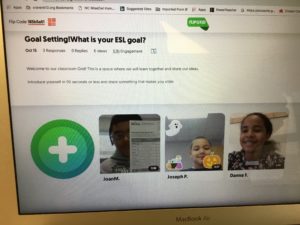
From there, students used technology (Flipgrid) to communicate their goals to others and listen to other students’ goals. They collected data about their peers’ goals. Then they interpreted the data and reported about it. For many, this was the first time that they had ever done an activity like this. I provided support in the form of vocabulary, sentence frames, and modeling responses.
A little later during the year, I sent a survey to the students through Google forms. 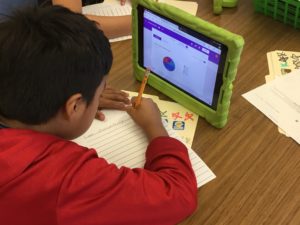 Students read the question and responded. As a class, students, interpreted the data and communicated it to each other and to the teacher. I collected the data using Google forms as a data collection instrument. Doing this activity, students got a little more time to practice interpreting and communicating data. This is a skill that I wanted them to be able to do with ease, so when they began their tomatosphere seed experiment, they would be able to collect data and
Students read the question and responded. As a class, students, interpreted the data and communicated it to each other and to the teacher. I collected the data using Google forms as a data collection instrument. Doing this activity, students got a little more time to practice interpreting and communicating data. This is a skill that I wanted them to be able to do with ease, so when they began their tomatosphere seed experiment, they would be able to collect data and
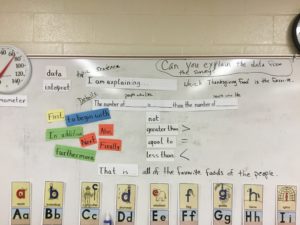 communicate it by themselves with relatively little support from the teacher.
communicate it by themselves with relatively little support from the teacher.
Students used the engineering design process to design and watch the creation of the planters that they would use to house the seeds and soil. I introduced the process to students when they asked about things that could hold the tomato seeds. The engineering design process is a cycle which guides students to deeper thinking and makes them ask questions about what they have chosen. 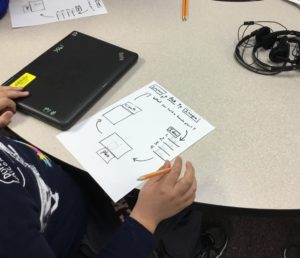 Finally, students designed what they believed to be the best device to hold the seeds. I shared my story about
Finally, students designed what they believed to be the best device to hold the seeds. I shared my story about
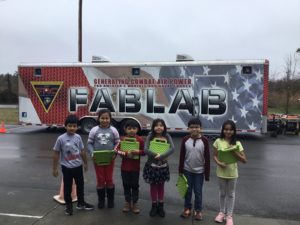 how I came up with the idea for the device and I showed them my design with the engineer from FRC-EAST using the CAD software. Later, the mobile FABLAB arrived and created the planter from the design. Students witnessed the CNC cutter and the 3D printers fabricating the device from the design software. They
how I came up with the idea for the device and I showed them my design with the engineer from FRC-EAST using the CAD software. Later, the mobile FABLAB arrived and created the planter from the design. Students witnessed the CNC cutter and the 3D printers fabricating the device from the design software. They
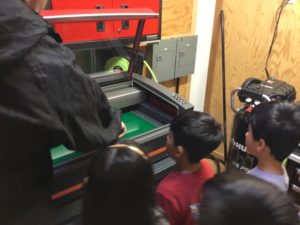 assembled the planter parts and created a set of instructions as technical writing.
assembled the planter parts and created a set of instructions as technical writing.
As they cultivated the seeds, students researched plants, plant life cycles, and tomatoes. They had a variety of means to do this: books (at various reading levels and genres), videos and recorded books, and interviews. 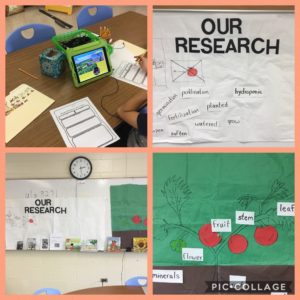 To present the information that they had gathered, students added facts on the virtual padlet, the physical anchor chart, and additionally “gamify”ed their facts by creating their very own Kahoot! games and challenging their classmates. This was a fun way for students to present their research and to provide feedback using a very innovative and fun formative assessment tool.
To present the information that they had gathered, students added facts on the virtual padlet, the physical anchor chart, and additionally “gamify”ed their facts by creating their very own Kahoot! games and challenging their classmates. This was a fun way for students to present their research and to provide feedback using a very innovative and fun formative assessment tool.
In creating their Kahoot! Games, students collaborated. 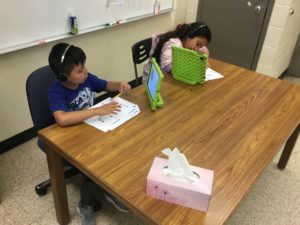
They also read for information, often re-reading and summarizing text to get facts to create their questions. 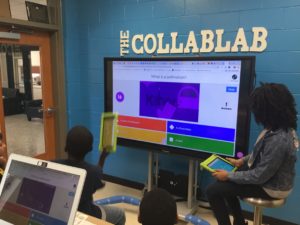 Many of the newcomer students, who don’t yet have the skills to read independently, listened to text to get facts. Scaffolding was provided in the form of sentence frames, vocabulary instruction, and for some, L1 support.
Many of the newcomer students, who don’t yet have the skills to read independently, listened to text to get facts. Scaffolding was provided in the form of sentence frames, vocabulary instruction, and for some, L1 support.
As the plants grew, students commented about the stages of the plants’ growth.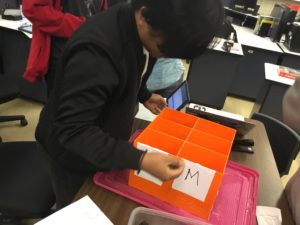
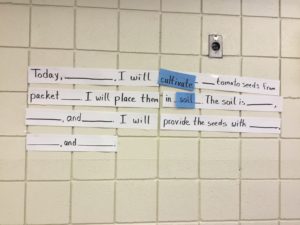 Students used the information that they had learned from texts, along with information from the Kahoot! games and conversations with their peers to describe the sprouts, seedlings, and growing plants.
Students used the information that they had learned from texts, along with information from the Kahoot! games and conversations with their peers to describe the sprouts, seedlings, and growing plants.
I have been very impressed at how well the students described the growing tomato plants using academic language, scientific vocabulary and discourse. 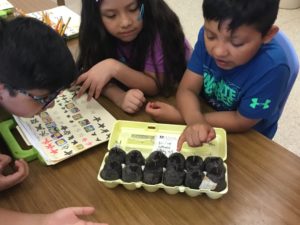 My theory about why this occurs is that they are experiencing this phenomenon for the first time and are using the only vocabulary that they know to describe it. As a result, there is no L2 delay with the process of explaining how the tomato plant grows. Also, many of the activities used to identify the processes of tomato plant growth are hands-on, thus the students are able to associate them with memorable experiences.
My theory about why this occurs is that they are experiencing this phenomenon for the first time and are using the only vocabulary that they know to describe it. As a result, there is no L2 delay with the process of explaining how the tomato plant grows. Also, many of the activities used to identify the processes of tomato plant growth are hands-on, thus the students are able to associate them with memorable experiences.
In addition to describing the plant growth cycle, students gathered data daily about the size, shape, and color of the sprouts as well as the rates of germination and growth. 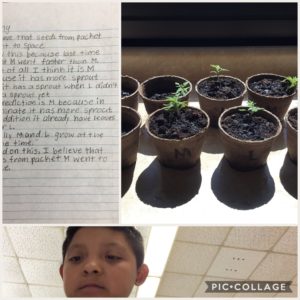
 Students compared these qualities to support their hypotheses about which of the seeds they believe went to the international space station. The scaffolds in place to help students explain this task are content vocabulary words and the sentence frames to structure their discourse. Students participated in scientific inquiry and investigation to gather and sort data to support their hypotheses about which seeds are the “space seeds”.
Students compared these qualities to support their hypotheses about which of the seeds they believe went to the international space station. The scaffolds in place to help students explain this task are content vocabulary words and the sentence frames to structure their discourse. Students participated in scientific inquiry and investigation to gather and sort data to support their hypotheses about which seeds are the “space seeds”.
During this unit, students have presented their data about the plants, their explanations about assembling planters, their explanations about how to cultivate seeds and about how plants grow. They have also given their hypotheses about which seeds are the space seeds. They’ve done this through technology, e.g. recorded statements via video and written essays about each. However, in seeking an audience for students to communicate everything that they’ve learned, that’s when we reconnected with 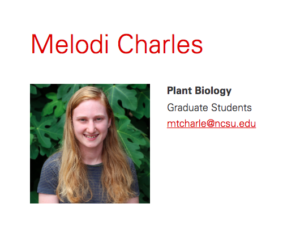 Melodi Charles, the Horticulture Scientist from NC State who initially gave us information about the tomatoes when the students were beginning their research. Students eloquently explained to her the entire process of designing a planter, growing tomatoes, and collecting data to hypothesize about which seeds were the “space seeds”. Then, ultimately transferring those plants to an outdoor garden space at school.
Melodi Charles, the Horticulture Scientist from NC State who initially gave us information about the tomatoes when the students were beginning their research. Students eloquently explained to her the entire process of designing a planter, growing tomatoes, and collecting data to hypothesize about which seeds were the “space seeds”. Then, ultimately transferring those plants to an outdoor garden space at school.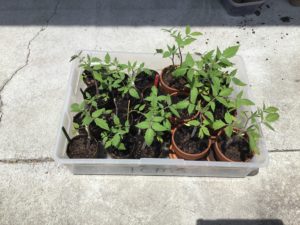
 So, as my Kenan Fellows project comes to an end, it is really just the beginning a new chapter of learning for my students and me. I am hopeful that the community/school gardens that have begun as a result of this project will be a source for further learning, not only in the STEM fields, but also in other fields such as economics (supply and demand), cultural celebrations centered around festival harvest days, as well as writing recipes and cooking healthy meals.
So, as my Kenan Fellows project comes to an end, it is really just the beginning a new chapter of learning for my students and me. I am hopeful that the community/school gardens that have begun as a result of this project will be a source for further learning, not only in the STEM fields, but also in other fields such as economics (supply and demand), cultural celebrations centered around festival harvest days, as well as writing recipes and cooking healthy meals.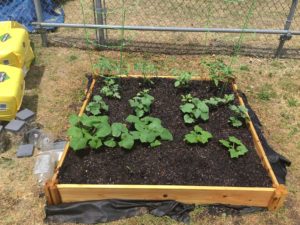
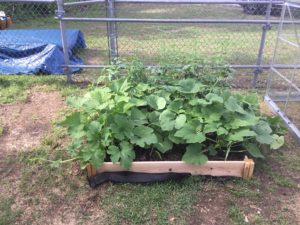 This entire project and all that has developed through it would not have been possible without The Kenan Fellows Program. The Kenan Fellows Program, to date, has delivered the best STEM professional development that I have ever received. Additionally, I was paired with engineers from FRC East and given a chance to job shadow them. Also, through the Kenan Fellows Program, I was able to create a vast network of STEM professionals and educators with whom I could collaborate both face to face and online. It was through The Kenan Fellows Program, also that I was able to learn about citizen science and participate in the Tomatosphere citizen science project.
This entire project and all that has developed through it would not have been possible without The Kenan Fellows Program. The Kenan Fellows Program, to date, has delivered the best STEM professional development that I have ever received. Additionally, I was paired with engineers from FRC East and given a chance to job shadow them. Also, through the Kenan Fellows Program, I was able to create a vast network of STEM professionals and educators with whom I could collaborate both face to face and online. It was through The Kenan Fellows Program, also that I was able to learn about citizen science and participate in the Tomatosphere citizen science project.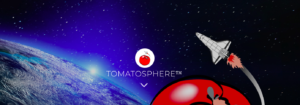 From there, through my Kenan Fellows network, I was able to learn about the NC Farm Bureau’s Ag in the Classroom program and secure a grant for the establishment of a school garden.
From there, through my Kenan Fellows network, I was able to learn about the NC Farm Bureau’s Ag in the Classroom program and secure a grant for the establishment of a school garden.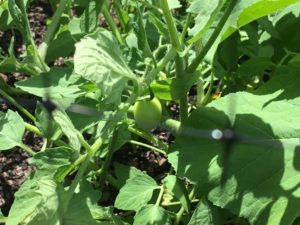
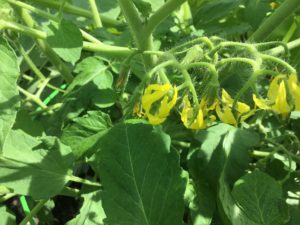
I also want to extend thanks to my school district’s leadership for allowing me to pursue all of these endeavors. Thanks to each of you, you have made this one of the best school year’s ever. You have helped to allow my students to develop an inquiry mindset while learning about STEM curriculum and opening their eyes to STEM careers all in a language-rich, supported environment.
